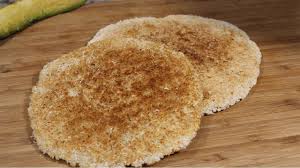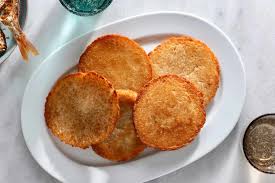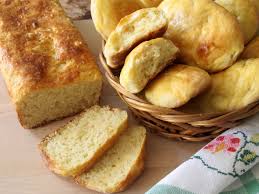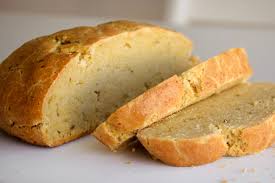Cassava bread is a delightful alternative for those seeking gluten-free options or simply looking to try something new. This traditional dish has its roots in various cultures, particularly among indigenous peoples of South America and Africa.
Made from the starchy cassava root, also known as yuca, this bread is not only tasty but also versatile. Whether enjoyed on its own or paired with soups, stews, or dips, cassava bread can easily complement a variety of meals.
The process of making cassava bread begins with the preparation of the cassava root. Cassava is a tuberous root vegetable that is rich in carbohydrates and provides essential nutrients such as vitamin C and potassium.
It’s important to note that cassava must be properly processed to eliminate the naturally occurring cyanogenic glycosides, which can be toxic. When prepared correctly, cassava becomes a safe and nutritious ingredient that can be used in many dishes.
To make cassava bread, you will need a few simple ingredients: fresh or dried cassava flour, water, and a pinch of salt. You can also customize your recipe by adding flavors or ingredients such as herbs, spices, or even cheese. The choice of additional ingredients can elevate the flavor and texture of the bread, making it even more enjoyable.
One of the best aspects of cassava bread is its ease of preparation. Unlike traditional bread that requires yeast and long rising times, cassava bread can be made quickly and easily.
This is especially beneficial for those who are new to baking or looking for a fast and satisfying option. The dough can be mixed and cooked in under an hour, making it a great choice for weeknight dinners or spontaneous gatherings.
The cooking method for cassava bread is also straightforward. The dough can be formed into flatbreads and cooked on a hot skillet or griddle, creating a crispy exterior while maintaining a soft and chewy interior.
Alternatively, you can bake it in the oven for a different texture. The versatility in cooking methods allows for experimentation, so you can choose the one that best suits your preference.
As a gluten-free option, cassava bread is an excellent choice for those with dietary restrictions. It is naturally free from gluten, making it safe for individuals with celiac disease or gluten intolerance. This makes it an appealing choice for various dietary needs while still providing a satisfying and filling bread option.
In addition to its health benefits, cassava bread is also an economical choice. Cassava flour is often more affordable than other gluten-free flours, making it accessible for many households. Its long shelf life means you can stock up on cassava flour and always have it on hand for spontaneous baking.
Cassava bread is a delicious, gluten-free alternative to traditional bread that is easy to prepare and versatile in use. With just a few simple ingredients and straightforward steps, you can create a tasty bread that complements a variety of dishes.
Whether you’re a seasoned cook or a beginner in the kitchen, this cassava bread recipe is sure to become a favorite in your culinary repertoire. Prepare to enjoy the unique flavors and textures of this delightful bread as you explore the world of cassava-based cooking
Ingredients Needed for Cassava Bread

1. Cassava Flour: Use finely ground cassava flour as the primary ingredient. It provides the bread with its distinct flavor and texture.
2. Water: Fresh water is essential to hydrate the flour and form a dough. The amount may vary depending on the desired consistency.
3. Salt: A pinch of salt enhances the flavor of the bread. It’s important to balance the taste without overwhelming the natural flavor of cassava.
4. Baking Powder: This ingredient acts as a leavening agent, helping the bread rise and giving it a lighter texture.
5. Oil or Butter: Adding oil or melted butter provides moisture and richness to the bread. Coconut oil is a popular choice for its flavor and health benefits.
6. Optional Ingredients: You can add ingredients like herbs, spices, or seeds for extra flavor and nutrition. Popular options include garlic powder, rosemary, or sesame seeds.
Preparing the Cassava
1. Peeling: Start by peeling the cassava roots to remove the tough outer skin. Use a sharp knife and take care not to waste too much of the flesh.
2. Washing: After peeling, rinse the cassava thoroughly under running water to remove any dirt or debris.
3. Boiling or Steaming: Cut the cassava into chunks and boil or steam until tender, which usually takes about 20-30 minutes. The cassava should be soft enough to mash.
4. Mashing: Drain the cooked cassava and let it cool slightly. Mash it using a fork or potato masher until smooth and free of lumps.
5. Cooling: Allow the mashed cassava to cool completely before mixing with other ingredients. This prevents any unwanted cooking of the dough.
Mixing the Ingredients
1. Combine Dry Ingredients: In a mixing bowl, combine the cassava flour, salt, and baking powder. Mix thoroughly to ensure even distribution of the leavening agent.
2. Add Wet Ingredients: Make a well in the center of the dry ingredients and add the mashed cassava, water, and oil or melted butter.
3. Mixing: Use a spatula or your hands to combine the ingredients until a dough forms. If the dough is too dry, add more water, a tablespoon at a time, until the desired consistency is achieved.
4. Kneading: Knead the dough for a few minutes until it becomes smooth and elastic. This step helps to develop the texture of the bread.
Read Also: Debeaking of Birds, the Need for Debeaking and the Ideal time for Debeaking the Birds
Shaping the Bread

1. Dividing the Dough: Divide the dough into equal portions based on the size of the bread you want to make. Each portion can weigh around 100-150 grams for individual loaves.
2. Shaping: Roll each portion into a ball, then flatten it slightly to form a disc. You can shape it into a traditional round loaf or a flatbread style, depending on your preference.
3. Resting: Let the shaped dough rest for about 15-20 minutes. This helps relax the gluten, making it easier to cook evenly.
4. Baking: Preheat the oven to 350°F (175°C). Place the shaped dough on a baking sheet lined with parchment paper. Bake for 25-30 minutes, or until the bread is golden brown and sounds hollow when tapped.
5. Cooling: Once baked, remove the bread from the oven and let it cool on a wire rack before slicing. This ensures a better texture and flavor.
Baking the Cassava Bread
1. Preheat the Oven: Before baking, ensure that your oven is preheated to 350°F (175°C). This allows the bread to cook evenly.
2. Place on Baking Sheet: Arrange the shaped cassava bread on a baking sheet lined with parchment paper. Make sure to leave some space between each piece to allow for expansion during baking.
3. Baking Time: Bake the cassava bread for 25-30 minutes, or until the top is golden brown and the bread sounds hollow when tapped on the bottom. If you prefer a crustier texture, you can bake it for an additional 5 minutes.
4. Check for Doneness: To ensure the bread is fully cooked, you can insert a toothpick into the center. If it comes out clean, the bread is ready.
Cooling the Bread
1. Remove from Oven: Once baked, carefully take the cassava bread out of the oven using oven mitts.
2. Transfer to Cooling Rack: Immediately transfer the bread to a wire cooling rack. This prevents steam from building up underneath the bread, which could make the bottom soggy.
3. Cooling Time: Allow the bread to cool for about 15-20 minutes. This cooling period helps set the texture and makes it easier to slice.
4. Slicing: After cooling, use a serrated knife to slice the bread. This helps maintain the structure and prevents it from crumbling.
Serving Suggestions
1. Spreadable Toppings: Serve the cassava bread warm or at room temperature with various spreads. Options include butter, coconut oil, or your favorite nut butter for added richness.
2. Savory Dishes: Pair the bread with savory dishes like soups, stews, or curries. Its slightly sweet flavor complements hearty meals beautifully.
3. Sandwiches: Use cassava bread as a gluten-free option for sandwiches. Fill it with your choice of proteins, veggies, and spreads for a nutritious meal.
4. Breakfast Delight: Serve with eggs, avocado, or fresh vegetables for a healthy breakfast option. You can also toast it for added crunch.
5. Snack Option: Cut the bread into smaller pieces and serve it as a snack with cheese or dips like hummus or salsa. This makes for a great appetizer or party snack.
Read Also: 15 Medicinal Health Benefits Of Echinacea purpurea (Purple Coneflower)
Tips for Perfect Cassava Bread

1. Use Fresh Cassava: Ensure that your cassava is fresh and free from any signs of spoilage. Fresh cassava yields better flavor and texture in your bread.
2. Grate Finely: When preparing the cassava, grate it finely for a smoother texture. This helps the dough mix well and ensures even cooking.
3. Adjust Liquid Levels: Depending on the moisture content of the cassava, you may need to adjust the liquid in your recipe. Start with the recommended amount and gradually add more if the dough feels too dry.
4. Knead Thoroughly: Knead the dough well to develop a good structure. This helps the bread rise better and creates a nice texture.
5. Check the Oven Temperature: Ovens can vary in temperature accuracy. Use an oven thermometer to ensure that it is set correctly for even baking.
6. Experiment with Flavorings: Add herbs, spices, or other flavorings to enhance the taste of your cassava bread. Garlic powder, rosemary, or cheese can add depth and richness.
7. Avoid Overbaking: Keep an eye on your bread towards the end of the baking time. Overbaking can lead to a dry texture.
Variations of Cassava Bread
1. Herbed Cassava Bread: Add fresh or dried herbs like thyme, basil, or oregano to the dough for a fragrant and flavorful bread.
2. Sweet Cassava Bread: Incorporate ingredients like honey, sugar, or cinnamon for a sweeter version, perfect for breakfast or as a dessert.
3. Cheese-Stuffed Cassava Bread: Add shredded cheese into the dough or fill the center of the bread before baking for a cheesy delight.
4. Spicy Cassava Bread: Mix in chopped jalapeños or chili flakes for a spicy kick that pairs well with savory dishes.
5. Nutty Cassava Bread: Incorporate ground nuts or seeds like almonds, walnuts, or flaxseeds into the dough for added texture and nutrition.
Nutritional Benefits of Cassava Bread
1. Gluten-Free: Cassava bread is naturally gluten-free, making it a suitable option for individuals with celiac disease or gluten sensitivity.
2. Rich in Carbohydrates: Cassava is a great source of carbohydrates, providing energy for daily activities. It serves as a good base for meals, particularly for those with high energy needs.
3. High in Fiber: The fiber content in cassava helps support digestive health, promoting regular bowel movements and reducing the risk of constipation.
4. Vitamins and Minerals: Cassava is rich in essential nutrients like vitamin C, folate, and potassium, which contribute to overall health and well-being.
5. Low in Fat: Cassava bread is low in fat, making it a heart-healthy option that can fit into various dietary plans.
Do you have any questions, suggestions, or contributions? If so, please feel free to use the comment box below to share your thoughts. We also encourage you to kindly share this information with others who might benefit from it. Since we can’t reach everyone at once, we truly appreciate your help in spreading the word. Thank you so much for your support and for sharing!
Read Also: How to Grow Your Business Quickly and Easily
Frequently Asked Questions
We will update this section soon.

